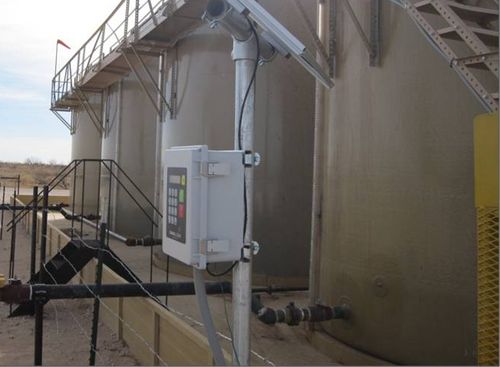Oct 26, 2011GreenHunter Water LLC a Grapevine, Texas, provider of water-management solutions and services to oil and gas companies, is installing the first of its new RFID-based well-head management system at six oil-drill sites in West Virginia. This deployment will enable the company to track wastewater pumped out of temporary storage tanks and subsequently deposited in authorized waste wells, and then share that data with its customer—the oil firm that owns and manages those drill sites, which has asked to remain unnamed.
The solution, known as RAMCAT (Remote Access Management Compliance Asset Tracking), employs ZigBee-based 2.4 GHz active RFID tags to not only track the amount of wastewater being offloaded from tanks, but also the movements of tank trucks transporting that fluid, thereby ensuring that they do not leave authorized roads.
Drilling for oil and natural gas in shale rock involves the high-pressure injection of water, sand and chemicals into a well, in order to break up the shale and allow the oil or gas to be extracted. The process, known as hydraulic fracturing (hydrofracking or fracking), generates large volumes of "flow back" water. The water is separated from the oil, stored in tanks on site, and later removed by truck to an authorized permanent location. Oil-drilling companies must follow strict state and federal regulations, including ensuring not only that the water is disposed of properly, but also that only designated roads are used to transport that water, in order to ensure that other public roads are not damaged. GreenHunter is among the companies that provide the tanks in which the water is stored, as well as removal services to approved disposal wells, using its own and third-party trucks. Details regarding the amount of liquid removed, and when this occurs, are typically recorded on paper by a driver or on-site operators, and the volume is estimated based on the length of time that a hose was connected to a tank and removing water.
GreenHunter has numerous oil-drilling customers, and is initially installing the new automated system for an oil firm that is headquartered in Ohio but operates drill sites with GreenHunter water tanks in West Virginia. GreenHunter removes water from the West Virginia site and transports it to a disposal well located in Ohio.
With the RAMCAT system, the top of the storage tank is fitted with a hydrogen sulfide (HS2) sensor and an automated valve with two built-in sensors—one to measure the level of water within a storage tank, and another to measure temperature. The sensor-and-valve unit is wired to a solar- and battery-powered kiosk with an embedded computer, integrated with a 2.4 GHz RFID transponder and GSM cellular and satellite communication technology. Temperature is important to measure, since the temperature of water affects the speed at which the liquid can be removed from the tank. The kiosk's computer stores information, including a unique ID number, sensor data and a list of authorized drivers who may access the tank to retrieve water.
When a kiosk's RFID tag detects a truck's transponder signal, it transmits its data (the temperature and quantity of water within the storage tank) at regular intervals. A transponder mounted on the vehicle can receive that transmission when it comes within approximately 50 meters (164 feet). Once the truck's transponder receives its transmission, it responds with its own unique identifier. The unit on the water tank than determines whether the ID is authorized. Next, the driver steps out of the truck and enters his PIN password on a keypad built into the kiosk. If the password is correct for that ID number, and if the ID has been authorized by the system, RAMCAT software on the kiosk's computer triggers the tank valve to open. If the individual is unauthorized, or if the password is not accepted, the computer issues an alert to the server, which, in turn, sends an alert to customer personnel via text message or e-mail. The data being transmitted between the two transponders is received by a gateway reader on site, and is forwarded to the back-end server.
As the driver offloads water from the tank, the water-level sensor within that tank tracks the amount of water being removed. If the driver goes to another tank located at the site, the quantity removed from that tank is added to his transportation activities record on the RAMCAT server. Once finished retrieving the water, the driver then travels on authorized roads to the disposal well. The truck's RAMCAT GPS unit tracks the vehicle's location in real time, and sends that data via a cellular or satellite connection.
At the disposal site, each well is also equipped with RAMCAT sensors and a computer kiosk with an RFID transponder, as well as a gateway reader. The transponder receives signals from the truck's tag, authorizes the ID number and unlocks the valve, allowing the driver to pump the waste into the disposal well. The amount of water being disposed of is measured using the RAMCAT unit, and the results are then stored on the RAMCAT server. In the event that there is a discrepancy in the amount of fluid entering the well compared with the amount offloaded from the truck's tank, an alert is sent to the oil company personnel, either via text or e-mail message.
By providing the location and sensor data to its customer, GreenHunter offers accountability in the form of automated reports and real-time data regarding trucks' movements, Sloan says, as well as where wastewater was removed, the amount removed and when it was properly disposed of. "Obviously for the oil and gas producer," he states, "they want to ensure the water goes to an EPA-approved well."
According to Sloan, GreenHunter is working with three more major oil companies that intend to utilize the system in the future.
The tank sensors and kiosk installed at a customer's temporary storage well are sold to that customer, which then pays a monthly service fee for access to data on the RAMCAT server. Customers also pay fees for water-removal and water-disposal services.



